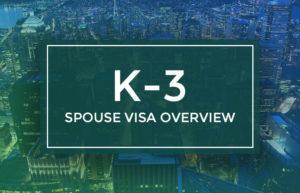K-3 Visa: Spouse Visa
The K-3 visa is for the foreign spouse of a U.S. citizen. It was designed to shorten the physical separation between the foreign national and his or her U.S. citizen spouse. Specifically, it allows the foreign national to enter the United States to await approval of the immigrant visa petition. K-3 visa recipients subsequently apply to adjust status to a permanent resident (green card holder) so that he or she may live permanently in the U.S. with the spouse.

The K-3 nonimmigrant visa is for the foreign-citizen spouse of a United States (U.S.) citizen. This visa category is intended to shorten the physical separation between the foreign-citizen and U.S. citizen spouses by having the option to obtain a nonimmigrant K-3 visa overseas and enter the United States to await approval of the immigrant visa petition.
K-3 visa recipients subsequently apply to adjust status to a permanent resident (LPR) with the Department of Homeland Security’s (DHS) U.S. Citizenship and Immigration Services (USCIS) upon approval of the petition.
Because the spouse of a U.S. citizen applying for a non immigrant K-3 visa must have an immigrant visa petition filed on his or her behalf by his or her U.S. citizen spouse and pending approval, a K-3 applicant must meet some of the requirements of an immigrant visa.
It should be noted that under U.S. immigration law, a foreign citizen who marries a U.S. citizen outside the U.S. must apply for the K-3 visa in the country where the marriage took place.
Eligible children of K-3 visa applicants receive K-4 visas. Both K-3 and the K-4 visas allow their recipients to stay in the U.S. while immigrant visa petitions are pending approval by USCIS.
How does U.S. immigration law define a spouse?
- A spouse is a legally wedded husband or wife.
- Merely living together does not qualify a marriage for immigration.
- Common-law spouses may qualify as spouses for immigration purposes depending on the laws of the country where the common-law marriage occurs.
- In cases of polygamy, only the first spouse may qualify as a spouse for immigration.
- Same-sex marriages are now recognized by immigration law for the purpose of immigrating to the U.S.
K-3 Visa Eligibility Requirements
- The visa beneficiary must be the legal spouse of a U.S. citizen. (Please note that spouses of green card holders are not eligible for a K-3 visa).
- The visa beneficiary must be currently residing outside the United States.
- The U.S. citizen must meet certain income requirements. This will be determined by the current adjusted HHS poverty guidelines.
- The U.S. citizen must have submitted an I-130 petition to sponsor the foreign spouse and the petition must be pending with the USCIS. In other words, the petitioner (the U.S. citizen) must have received a receipt notice from the USCIS, but the petition must not have been approved yet.
- If the foreign spouse has children (biological or adopted) who will also come to the U.S. on a K-1 visa, the children must be under the age of 21 and unmarried.
K-3 Application Process
Before starting the K-3 visa process, the U.S. citizen spouse must file Form I-130, Petition for Alien Relative, with U.S. Citizenship and Immigration Services (USCIS). Form I-130 establishes a qualified relationship for the purposes of a family-based permanent residence application. Once USCIS accepts the I-130 petition for processing and replies with a receipt letter (Form I-797C, Notice of Action), the U.S. citizen may then file Form I-129F, Petition for Alien Fiancé, to start the K-3 visa process. Upon approval for Form I-129F, the case is moved to the U.S. embassy or consulate in the foreign national’s country of residence.
At this point the foreign national may apply for the K-3 visa through the embassy or consulate. The K-3 applicant should expect to go to an immigration medical exam and attend an interview. Upon approval of the K-3 visa, the foreign national may enter the United States. Once in the U.S., he or she may file Form I-485, Application to Adjust Status.
Children of a K-3 Visa Holder
Eligible children of K-3 beneficiaries receive K-4 visas. Eligible children include unmarried sons and daughters under the age of 21. Eligible children may apply for K-4 visas based on the parent’s Form I-129F, Petition for Alien Fiancé. But the children must be on the petition. Separate visa applications must be submitted for each K-4 visa applicant, and each applicant must pay the K visa application fee.
Upon entry to the United States, his or her children must file separate adjustment of status applications. They cannot be included on parent’s Form I-485. Additionally, to qualify for adjustment of status, the child must have been under the age of 18 when the parent and U.S. citizen marry.
Problem with the K-3 Process
For most people, the K-3 process is not worthwhile. That’s because USCIS will generally approve the Form I-130 as quickly as the K-3 status. For that reason, many people who start the K-3 process are never issued the K-3 visa. Instead, they interview soon after the I-130 approval and enter the United States with an immigrant visa.
Click Here to Get Skylex app for client
